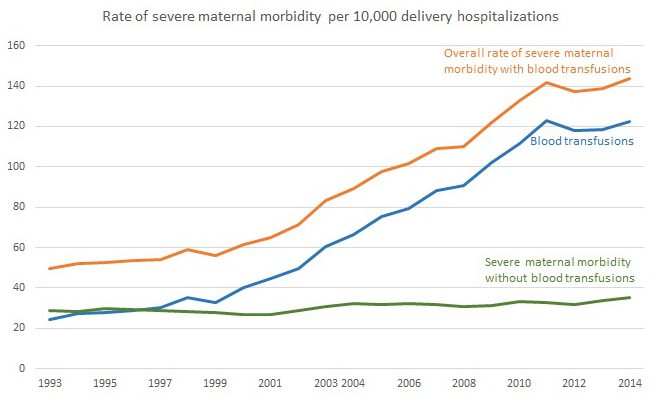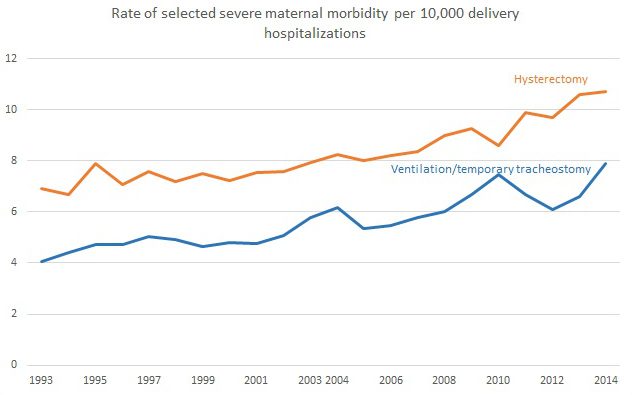Severe Maternal Morbidity in the United States
Severe maternal morbidity (SMM) includes unexpected outcomes of labor and delivery that result in significant short- or long-term consequences to a woman’s health.1 Using the most recent list of indicators, SMM has been steadily increasing in recent years and affected more than 50,000 women in the United States in 2014. This web report updates our previous report by adding information about SMM for 2014, the most recent year for which data are available on a national level.
It is not entirely clear why SMM is increasing, but changes in the overall health of the population of women giving birth may be contributing to increases in complications. For example, increases in maternal age,2 pre-pregnancy obesity,3,4 preexisting chronic medical conditions,5,6 and cesarean delivery2,7 have been documented. The consequences of the increasing SMM prevalence, in addition to the health effects for the woman, are wide-ranging and include increased medical costs and longer hospitalization stays.8 Tracking and understanding patterns of SMM, along with developing and carrying out interventions to improve the quality of maternal care are essential to reducing SMM.
How Does CDC Identify Severe Maternal Morbidity?
To identify delivery hospitalizations with SMM, CDC uses administrative hospital discharge data and International Classification of Diseases (ICD) diagnosis and procedure codes. The original list of 25 SMM indicators based on the 9th Revision of ICD was published in 2012.8 In October 2015, the United States transitioned to the 10th Revision of ICD to code diagnoses and procedures. CDC, along with our clinical and public health partners, took the opportunity to review this new version of ICD coding to update the indicators, taking into account results from validation studies. The updated list of 21 indicators and corresponding ICD codes used to identify delivery hospitalizations with SMM for both ICD-9 and ICD-10 can be used to track SMM when using administrative hospital discharge data from October 2015 and beyond.
Trends in Severe Maternal Morbidity
The following figures show trends over time in SMM in the United States from 1993–2014 using data from the National Inpatient Sampleexternal icon.
Severe Maternal Morbidity, 1993–2014

This figure shows the rate of SMM per 10,000 delivery hospitalizations from 1993–2014. Women who received blood transfusions (procedure in which a patient is given donated blood, generally in response to excessive bleeding around delivery) account for the greatest fraction of women with SMM. Hence, the SMM rates are shown for women with any indicator of SMM, women who had only transfusion as an indicator, and women who had some indicator other than transfusion.
The overall rate of SMM increased almost 200% over the years, from 49.5 in 1993 to 144.0 in 2014. This increase has been mostly driven by blood transfusions, which increased from 24.5 in 1993 to 122.3 in 2014. After excluding blood transfusions, the rate of SMM increased by about 20% over time, from 28.6 in 1993 to 35.0 in 2014.
Selected Severe Maternal Morbidity, 1993—2014

After excluding blood transfusions, the next most common SMM procedures are hysterectomy (surgical removal of the uterus) and ventilation or temporary tracheostomy (using a machine or inserting a tube into the airway to help a patient breathe). This figure shows the rate of hysterectomy and ventilation or temporary tracheostomy per 10,000 delivery hospitalizations from 1993–2014.
The rate of hysterectomy increased about 55% over time, from 6.9 in 1993 to 10.7 in 2014. The rate of ventilation or temporary tracheostomy increased by about 93% over the years, from 4.1 in 1994 to 7.9 in 2014.
Rates in Severe Morbidity Indicators per 10,000 Delivery Hospitalizations, 1993–2014
Access the table here.
Severe Maternal Morbidity Indicators and Corresponding ICD Codes during Delivery Hospitalizations
Access the table which includes the list of 21 indicators and corresponding ICD codes used to identify delivery hospitalizations with SMM.
- American College of Obstetricians and Gynecologists and the Society for Maternal–Fetal Medicine, Kilpatrick SK, Ecker JL. Severe maternal morbidity: screening and review external icon. Am J Obstet Gynecol. external icon2016;215(3):B17–B22.
- Martin JA, Hamilton BE, Osterman MJK, Driscoll AK, Matthews TJ. Births: final data for 2015pdf icon[PDF – 1.63MB]. Nat Vital Stat Rep. 2017;66(1).
- Hinkle SN, Sharma AJ, Kim SY. Prepregnancy obesity trends among low-income women, United States, 1999–2008external icon. Matern Child Health J. 2012;16(7):1339-1348.
- Fisher SC, Kim SY, Sharma AJ, Rochat R, Morrow R. Is obesity still increasing among pregnant women? Prepregnancy obesity trends in 20 states, 2003–2009external icon. Prev Med. 2013;56(6):372-378.
- Campbell KH, Savitz D, Werner EF, Pettker CM, Goffman D, Chazotte C, Lipkind HS. Maternal morbidity and risk of death at delivery hospitalization.external icon Obstet Gynecol. 2013;122(3):627–633.
- Small MJ, James AH, Kershaw T, Thames B, Gunatilake R, Brown H. Near-miss maternal mortality: cardiac dysfunction as the principal cause of obstetric intensive care unit admissions.external icon Obstet Gynecol. 2012;119(2 Pt 1):250–255.
- Barber EL, Lundsberg LS, Belanger K, Pettker CM, Funai EF, Illuzzi JL. Indications contributing to the increasing cesarean delivery rate.external icon Obstet Gynecol. 2011;118(1):29–38.
- Callaghan WM, Creanga AA, Kuklina EV. Severe maternal morbidity among delivery and postpartum hospitalizations in the United States.external icon Obstet Gynecol. 2012;120(5):1029–1036.